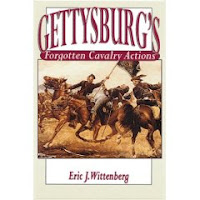
Gettysburg's Forgotten Cavalry Actions, Wittenberg, Eric J., Thomas Publications, paperback, 182 pp., photographs, maps, notes, index, 1998, $12.95
The cavalry actions at Gettysburg are often reduced to Buford's Federal Cavalry Division defending itself from attacks from Heth's Confederate Division. Some narratives give a nod to the July 3rd cavalry fight, between Gregg and Stuart east of Gettysburg, especially as it relates to the Pickett, Pettigrew, Trimble Charge. Less frequently, the Federal cavalry charge on the Confederate right flank is discussed as a coda to the famed CSA charge on the Federal center. This book focuses upon the Federal cavalry attacks on the Confederate right on July 3rd: Farnsworth's Charge, Merritt's Charge, south of the Big Round Top and Starr's 6th U.S. Cavalry Charge at Fairfield, eight miles into the Confederate rear.
A reader who approaches this book as a story of Gettysburg cavalry triva, would be in errror. This work is the story of remarkable and heroic soldiers ordered into unplanned battles that occurred on the Confederate right flank after the Pickett- Pettigrew-Trimble Charge. The outcome of this late afternoon July 3rd fight set in part the tenor of the Federal pursuit on July 5th.
The author sets the stage for these climatic and crucial fights: two engagements of Federal cavalry versus Confederate infantry on the Rebel right and one engagement of Federal cavalry versus Confederate cavalry in the Rebel rear. Wiitenberg is thorough and brief in his presentation; the key officers, the terrain, the condition of the troops engaged and their weapons are concisely presented. The conflicts are illustrated with clear, well drawn maps. An ample number of portaits of officers, monuments, farmsteads, and terrain accompany the text. The strategic situation of July 3rd is covered as are the personalities of the leaders. Personal accounts of the battles from the rank and file are generous in number and appropriate the moving the action forward in the book.
The laziness of Major General Alfred Pleasanton, commander of the Federal cavalry of the Army of the Potomac is revealed. The rashness of Brigadier General Judson Kilpatrick, commander of the 3rd Federal cavalry division is described. The heroic attributes of Brigadier Generals Wesley Merritt and Elon Farnsworth are presented. The question of Farnsworth suicide in order to escape capture is thoroughly grounded in both USA and CSA eyewitness reports. The story of the two troopers who won Medals of Honor at Fairfield leaves this reader asking for recognition for these heroics on this particular battlefield.
Infantrymen and artillerymen are not neglected in this book. It is refreshing to have Confederate diarists quoted in describing their enemy's assaults. The bravery of Law's Alabamians, Robertson's Texans, and Anderson's Georgians, supported by CSA artillerymen is equal to their Federal counterparts. Wittenberg's writing style is both clear and concise. No extra information pads the book; no essential information is left out. The book is not a tourguide with maps and designated stops, though it works well as such; the accompanying maps are not vague and the photographs of the monuments allow the reader to use it as a tourguide. This reviewer recommends this book to both the casual reader and those who subscribe to Gettysburg Magazine. It is essential reading for anyone taking the Licensed Battlefield Guide exam.


No comments:
Post a Comment